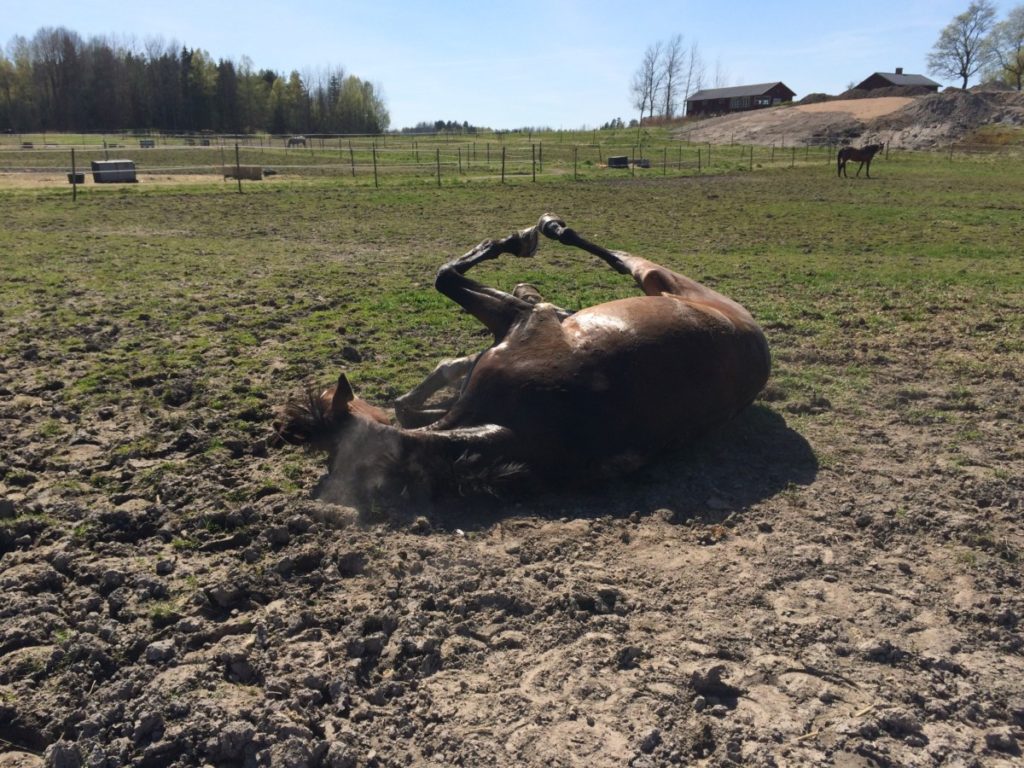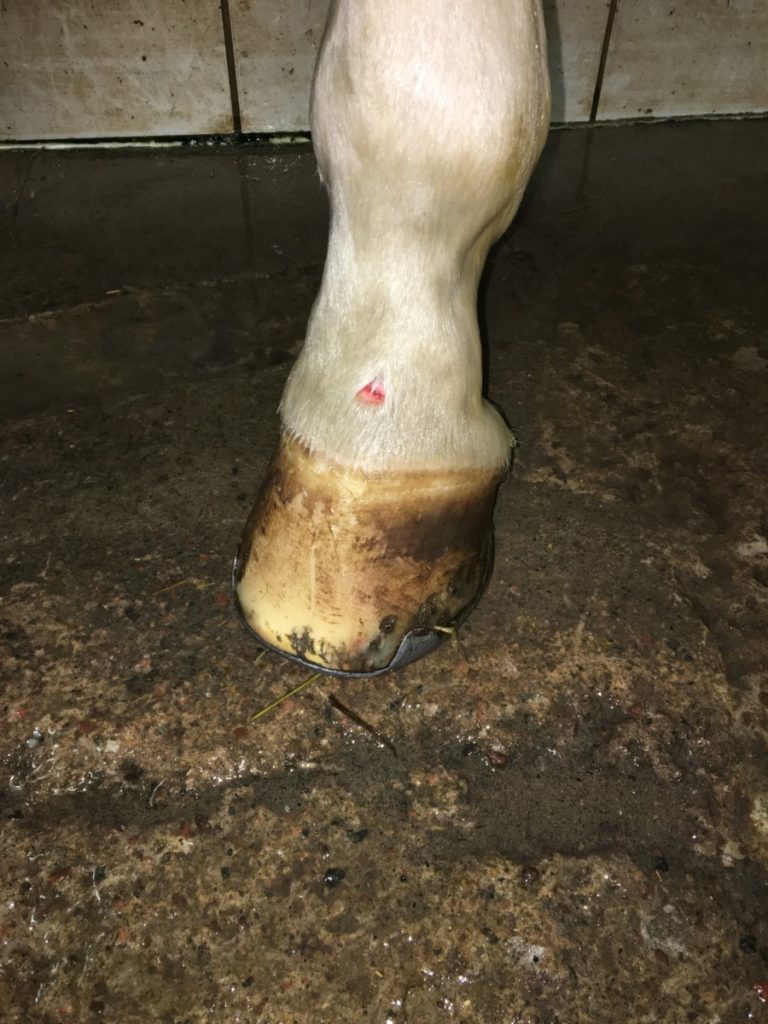Historically, a horse’s hoof color was used as a measure of its potential usefulness. Although this reasoning was baseless and incorrect, the color of a horse’s hoof isn’t totally insignificant or even consistent either.
A horse’s hoof can change color. In fact, in some cases, it is totally normal for a horse’s hoof to change color. When this color change is coupled with negative symptoms like limping or discomfort, it may be a sign of an underlying medical issue.
Even though a change in a horse’s hoof color isn’t a death sentence, it is important that you are aware of the cause of this change in order to properly address it. In order to do this, you need to know what is normal for your horse.

What is a Normal Hoof Color?
Horse’s can have a hoof color of white, black, or a combination of both. Typically, a horse’s hoof will match the pattern of their leg hair. For example, an all-black horse will likely have four all-black hooves, but a horse with a mixture of colors on its legs will likely have mixed colored hooves.
Like most things with pets, you have to know your horse to know what is normal for them, and this level of familiarity takes time. As long as your horse isn’t experiencing discomfort when trying to walk, there is no reason to assume that something is wrong.
Now, the alteration of a horse’s hoof is rather uncommon in domesticated horses, but there are a few circumstances where you can expect for your horse’s hooves to change color.
What Causes a Horse’s Hoof to Change Color?
White Line Disease
White Line Disease, also known as seedy toe, refers to a fungal and/or bacterial infection that eats away at a horse’s hoof. The infection is progressive and if left untreated, will damage the hoof until the horse can no longer walk.
Contrary to what the name would have you believe, the “white line” isn’t the first sign of the disease. The “white line” is a reference to the area on a horse’s foot where the hoof wall and the sole of the foot meet. This area often appears white on a horse, hence the name.
If the sole of the horse’s foot becomes separated from the hoof wall, this leaves the horse vulnerable to this infection as there are several ways that white line disease can begin to develop in the hoof.
One of the first noticeable signs that your horse has white line disease is the presence of powdery or crumbly dark tissue at the white line of the hoof. This is often discovered during routine trimmings, and if this is the only unusual thing that is observed, then it is likely that the disease is very early in its progression.
If the dark tissue is accompanied by visible damage to the hoof wall or sunken or raised areas of the hoof, then it is important that you seek medical attention for your horse as soon as possible.
There are solutions and products that can successfully treat white line disease, so this infection will not automatically call for your horse to enter early retirement. Even so, it is vital that you catch this infection before it spreads and causes significant damage to ensure a speedy recovery for your horse.

Changes in Diet
Wild horses who forage for their food are subject to the changes that their food goes through as the seasons change.
During the growing season, the nutrient content in the grass and other plants increases. The added nutrients can cause light-colored rings to appear around the horse hooves. This change is temporary, and the rings will fade as the horse’s diet changes.
Domesticated horses are less likely to be affected by the changes in the level of nutrients of the plants in their environment because they do not have to rely on nature to provide the bulk of their diet. In addition to eating grass, horses who have been domesticated have caretakers that feed them other things like hay, rolled oats, and bran.
Grass and other plants inevitably make a much smaller percentage of the horse’s nutrient intake, making the effects of the seasons less dramatic on the horse.
There is no treatment for a change in hoof pigment due to changes in a diet because this color change has no negative effect on the horse. These rings are purely cosmetic and will not cause your horse any pain at all.
Corns and other Bruising
Corns are a specific type of bruise that occurs on the sole of a horse’s hoof between the hoof wall and the bars also known as the seat of corn. This type of bruising is often the result of ill-fitting shoes or other trauma afflicted in the same area and usually results in hemorrhaging.
There are three different types of corns depending on the level of inflammation that has been allowed to develop and the fluid build up in the hoof.
- Dry corns –– A hemorrhage that causes thinning of the sole at the seat of corn.
- Moist corns –– a collection of inflammatory fluid as a result of bruising
- Suppurating corns –– Pus formation that has developed under the sole at the seat of the corn due to penetration of the hoof.
One visible symptom of dry corns is red bruising over the infected area. This color distortion may be difficult to find without the affected horn (hoof wall) growing downward. All three types can be visibly diagnosed when the overlaying sole is pared away.
Although all types of corns have some sort of visible symptom, a more certain diagnosis will come from the level of discomfort your horse is experiencing. Some of which include:
- The horse’s foot feeling unnaturally warm to the touch
- Signs of lameness
- Pain response to hoof testers
- Increased digital horse strength
There are ways to treat corns without further damaging the hoof. First, the shoes of the injured foot must be removed in order to properly treat the infected area.
Suppurating corns require draining to remove the collected pus. Dry corns only needs to be pared with a hoof knife in order to relieve pressure, and moist corns can be treated in the same way. The hoof then must be dressed and bandaged appropriately, and the horse needs to rest until it has recovered.
Thrush is an Unwanted Infection
Thrush is an infection of a horse’s frog (the underside of a horse’s foot extending from the toe to the heel) caused by unsanitary stall conditions and excessive moisture.
This infection, which is usually bacterial but can be fungal on occasion, is characterized by foul-smelling black discharge in the affected area of the frog. If this infection is left untreated long enough or is especially aggressive, then the frog could suffer significant damage leaving more sensitive tissue exposed.
Although the color and smell of the infection are enough to diagnose it as thrush, your horse may also experience pain when applying pressure on the foot in question.
In order to treat thrush, the horse must be removed from the unclean environment into a dry, clean area, the infected foot needs to be cleaned and pared to remove the damaged tissue, and the frog should be scrubbed daily with a dilute iodine solution.
Sometimes a Horse’s Hoof Will Change Color
As long as you have routine maintenance for your horse and its area and keep it on a consistent diet, you shouldn’t have to worry about any color changes in any of its hooves. If you notice any suspicious pigmentation, pay close attention to your horse’s behavior as this may be an early sign of an infection.
